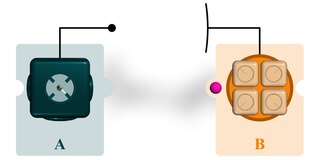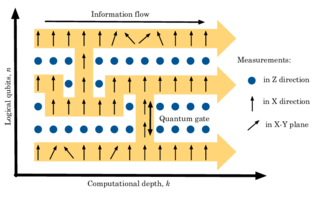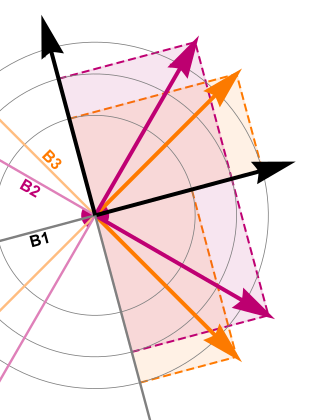In physics, the no-cloning theorem states that it is impossible to create an independent and identical copy of an arbitrary unknown quantum state, a statement which has profound implications in the field of quantum computing among others. The theorem is an evolution of the 1970 no-go theorem authored by James Park, in which he demonstrates that a non-disturbing measurement scheme which is both simple and perfect cannot exist. The aforementioned theorems do not preclude the state of one system becoming entangled with the state of another as cloning specifically refers to the creation of a separable state with identical factors. For example, one might use the controlled NOT gate and the Walsh–Hadamard gate to entangle two qubits without violating the no-cloning theorem as no well-defined state may be defined in terms of a subsystem of an entangled state. The no-cloning theorem concerns only pure states whereas the generalized statement regarding mixed states is known as the no-broadcast theorem.

Quantum teleportation is a technique for transferring quantum information from a sender at one location to a receiver some distance away. While teleportation is commonly portrayed in science fiction as a means to transfer physical objects from one location to the next, quantum teleportation only transfers quantum information. The sender does not have to know the particular quantum state being transferred. Moreover, the location of the recipient can be unknown, but to complete the quantum teleportation, classical information needs to be sent from sender to receiver. Because classical information needs to be sent, quantum teleportation cannot occur faster than the speed of light.

Quantum entanglement is the phenomenon of a group of particles being generated, interacting, or sharing spatial proximity in such a way that the quantum state of each particle of the group cannot be described independently of the state of the others, including when the particles are separated by a large distance. The topic of quantum entanglement is at the heart of the disparity between classical and quantum physics: entanglement is a primary feature of quantum mechanics not present in classical mechanics.

Quantum decoherence is the loss of quantum coherence. Quantum decoherence has been studied to understand how quantum systems convert to systems which can be explained by classical mechanics. Beginning out of attempts to extend the understanding of quantum mechanics, the theory has developed in several directions and experimental studies have confirmed some of the key issues. Quantum computing relies on quantum coherence and is the primary practical applications of the concept.

LOCC, or local operations and classical communication, is a method in quantum information theory where a local (product) operation is performed on part of the system, and where the result of that operation is "communicated" classically to another part where usually another local operation is performed conditioned on the information received.

In physics, in the area of quantum information theory, a Greenberger–Horne–Zeilinger state is a certain type of entangled quantum state that involves at least three subsystems. The four-particle version was first studied by Daniel Greenberger, Michael Horne and Anton Zeilinger in 1989, and the three-particle version was introduced by N. David Mermin in 1990. Extremely non-classical properties of the state have been observed. GHZ states for large numbers of qubits are theorized to give enhanced performance for metrology compared to other qubit superposition states.
The W state is an entangled quantum state of three qubits which in the bra-ket notation has the following shape
In quantum computing, a graph state is a special type of multi-qubit state that can be represented by a graph. Each qubit is represented by a vertex of the graph, and there is an edge between every interacting pair of qubits. In particular, they are a convenient way of representing certain types of entangled states.

The one-way or measurement-based quantum computer (MBQC) is a method of quantum computing that first prepares an entangled resource state, usually a cluster state or graph state, then performs single qubit measurements on it. It is "one-way" because the resource state is destroyed by the measurements.

In quantum information theory, a set of bases in Hilbert space Cd are said to be mutually unbiased to mean, that, if a system is prepared in an eigenstate of one of the bases, then all outcomes of the measurement with respect to the other basis are predicted to occur with an equal probability inexorably equal to 1/d.
Entanglement distillation is the transformation of N copies of an arbitrary entangled state into some number of approximately pure Bell pairs, using only local operations and classical communication.
Linear optical quantum computing or linear optics quantum computation (LOQC), also photonic quantum computing (PQC), is a paradigm of quantum computation, allowing (under certain conditions, described below) universal quantum computation. LOQC uses photons as information carriers, mainly uses linear optical elements, or optical instruments (including reciprocal mirrors and waveplates) to process quantum information, and uses photon detectors and quantum memories to detect and store quantum information.

Quantum complex networks are complex networks whose nodes are quantum computing devices. Quantum mechanics has been used to create secure quantum communications channels that are protected from hacking. Quantum communications offer the potential for secure enterprise-scale solutions.
In quantum mechanics, weak measurements are a type of quantum measurement that results in an observer obtaining very little information about the system on average, but also disturbs the state very little. From Busch's theorem the system is necessarily disturbed by the measurement. In the literature weak measurements are also known as unsharp, fuzzy, dull, noisy, approximate, and gentle measurements. Additionally weak measurements are often confused with the distinct but related concept of the weak value.
The KLM scheme or KLM protocol is an implementation of linear optical quantum computing (LOQC) developed in 2000 by Emanuel Knill, Raymond Laflamme and Gerard J. Milburn. This protocol allows for the creation of universal quantum computers using solely linear optical tools. The KLM protocol uses linear optical elements, single-photon sources and photon detectors as resources to construct a quantum computation scheme involving only ancilla resources, quantum teleportations and error corrections.
In quantum computing, Mølmer–Sørensen gate scheme refers to an implementation procedure for various multi-qubit quantum logic gates used mostly in trapped ion quantum computing. This procedure is based on the original proposition by Klaus Mølmer and Anders Sørensen in 1999-2000.
Optical cluster states are a proposed tool to achieve quantum computational universality in linear optical quantum computing (LOQC). As direct entangling operations with photons often require nonlinear effects, probabilistic generation of entangled resource states has been proposed as an alternative path to the direct approach.
In quantum physics, the "monogamy" of quantum entanglement refers to the fundamental property that it cannot be freely shared between arbitrarily many parties.
This glossary of quantum computing is a list of definitions of terms and concepts used in quantum computing, its sub-disciplines, and related fields.











































